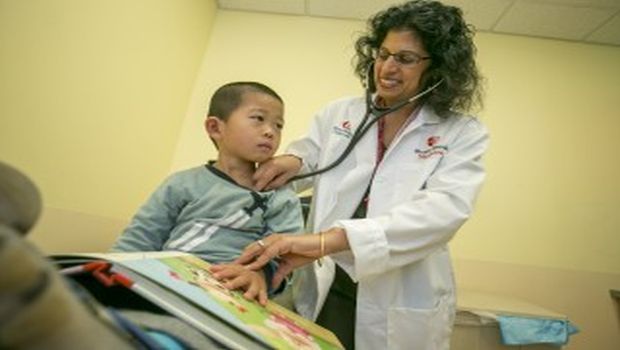Child Vaccination Rates Improve with Home Intervention and Education
A program by Stony Brook Children’s Hospital that involves the use of trained community health workers on child immunization reveals that home intervention and education improves vaccine/immunization rates in at-risk children, including those living in poverty. Overall, the intervention improved the likelihood of up-to-date immunization status by more than 15 percent for children up to 2 years of age compared to those without the intervention. The study involved more than 300 pediatric patients and is published in the journal Vaccine.


Dr. Susmita Pati of Stony Brook Children’s Hospital is leading a program that incorporates home intervention and education to improve immunization rates in at-risk children.
A program by Stony Brook Children’s Hospital that involves the use of trained community health workers on child immunization reveals that home intervention and education improves vaccine/immunization rates in at-risk children, including those living in poverty. Overall, the intervention improved the likelihood of up-to-date immunization status by more than 15 percent for children up to 2 years of age compared to those without the intervention. The study involved more than 300 pediatric patients and is published in the journal Vaccine.
According to the Centers for Disease Control and Prevention (CDC), vaccination remains a public health imperative, yet disparities in vaccination rates persist. While immunization coverage and rates for children has overall improved, children from families below the federal poverty level continue to fall short of recommended immunizations against potentially life-threatening diseases.
“We developed a protocol of an enriched medical home intervention using community health worker home visitation to improve early childhood immunization up-to-date status,” says Susmita Pati, MD, MPH, chief of the Division of Primary Care Pediatrics, and associate professor of pediatrics at Stony Brook Children’s Hospital. “We found this demonstrated a positive impact on increasing immunization rates, especially for vulnerable children such as those living in poverty.”
The study results stem from a Stony Brook Children’s Hospital Enriched Medical Home Intervention (EMHI) voluntary program that is offered to families whose children are considered at-risk for poor outcomes due to healthcare disparities. The children range from newborn to less than two years of age. In the study, titled “An enriched medical home intervention using community health workers improves adherence to immunization schedules,” the analysis of immunization rates included 201 children in the usual care group and 110 children in the intervention group. The age-specific immunization up-to-date status was defined by CDC guidelines.
After adjusting for differences in group characteristics, Pati and colleagues reported a significant increase in the likelihood of having up-to-date immunizations for the intervention group. The likelihood for newborns having up-to-date immunizations was nearly 21 percent higher, and toddlers nearly 17 percent higher in the intervention group, compared to non-intervention group receiving the usual clinical care only.
The EMHI protocol included trained health community workers who compiled patient immunization history and socio-demographic data. With that information, they educated families by way of scheduled family visits supplemented by outreach phone calls and text messages to further support their understanding of the importance of immunization and the individual child’s immunization record and needs.
“We believe this community health worker program integrated with the medical home has important implications for clinical practice and policy implementation,” says Pati. “With further study, our model may provide a cost-effective approach to improving childhood vaccination rates.”
Co-authors of the study include: Kristi L. Ladowski, MPH, and Angie T. Wong, MHS, Department of Pediatrics, Stony Brook University School of Medicine; Jiayu Huang, MS, of the Department of Applied Mathematics & Statistics; and Jie Yang, PhD, of the Department of Preventive Medicine, Stony Brook University School of Medicine.
The Stony Brook University School of Medicine Targeted Research Opportunity Award funded the research evaluation.
Source: Stony Brook University
Revolutionizing Infection Prevention: How Fewer Hand Hygiene Observations Can Boost Patient Safety
December 23rd 2024Discover how reducing hand hygiene observations from 200 to 50 per unit monthly can optimize infection preventionists' time, enhance safety culture, and improve patient outcomes.
Redefining Competency: A Comprehensive Framework for Infection Preventionists
December 19th 2024Explore APIC’s groundbreaking framework for defining and documenting infection preventionist competency. Christine Zirges, DNP, ACNS-BC, CIC, FAPIC, shares insights on advancing professional growth, improving patient safety, and navigating regulatory challenges.
Addressing Post-COVID Challenges: The Urgent Need for Enhanced Hospital Reporting Metrics
December 18th 2024Explore why CMS must expand COVID-19, influenza, and RSV reporting to include hospital-onset infections, health care worker cases, and ER trends, driving proactive prevention and patient safety.
Announcing the 2024 Infection Control Today Educator of the Year: Shahbaz Salehi, MD, MPH, MSHIA
December 17th 2024Shahbaz Salehi, MD, MPH, MSHIA, is the Infection Control Today 2024 Educator of the Year. He is celebrated for his leadership, mentorship, and transformative contributions to infection prevention education and patient safety.
Pula General Hospital Celebrates Clean Hospitals
December 16th 2024Learn how Pula General Hospital in Croatia championed infection prevention and environmental hygiene and celebrated Clean Hospitals Day to honor cleaning staff and promote advanced practices for exceptional patient care and safety.